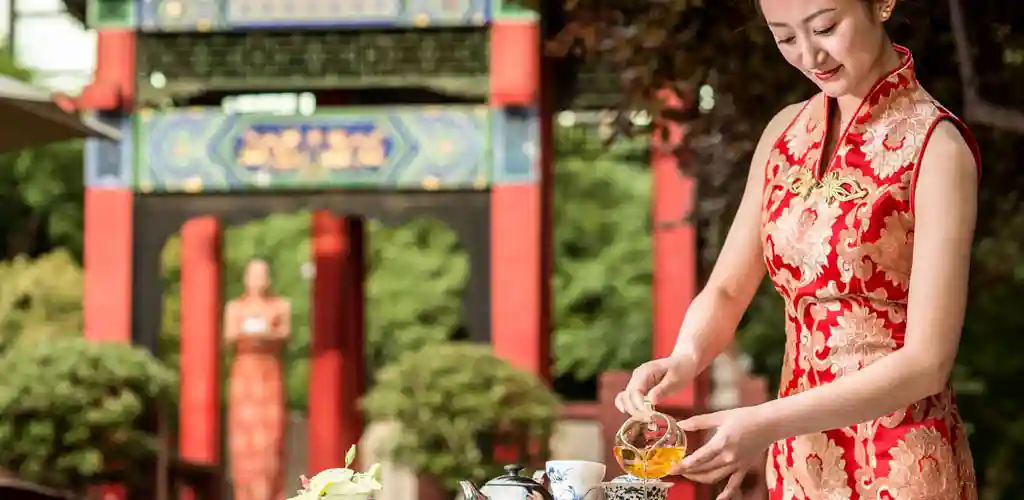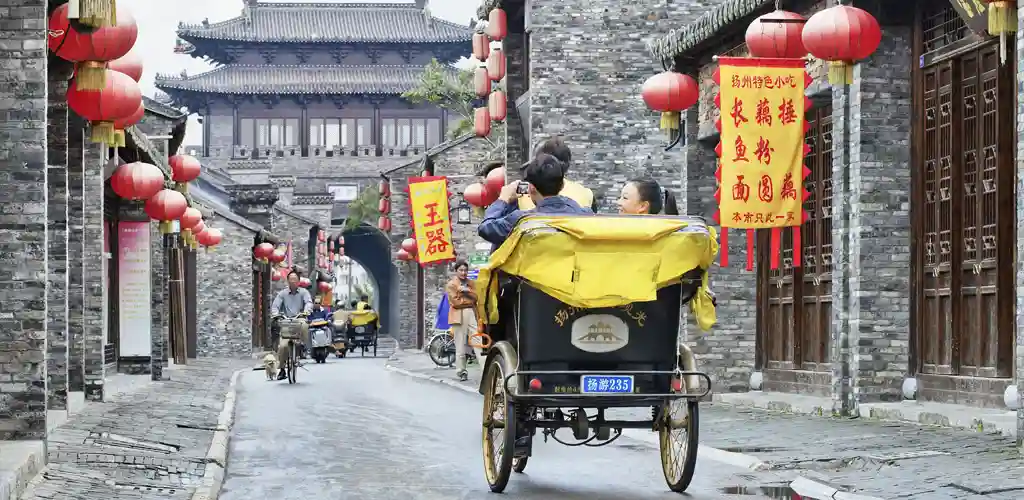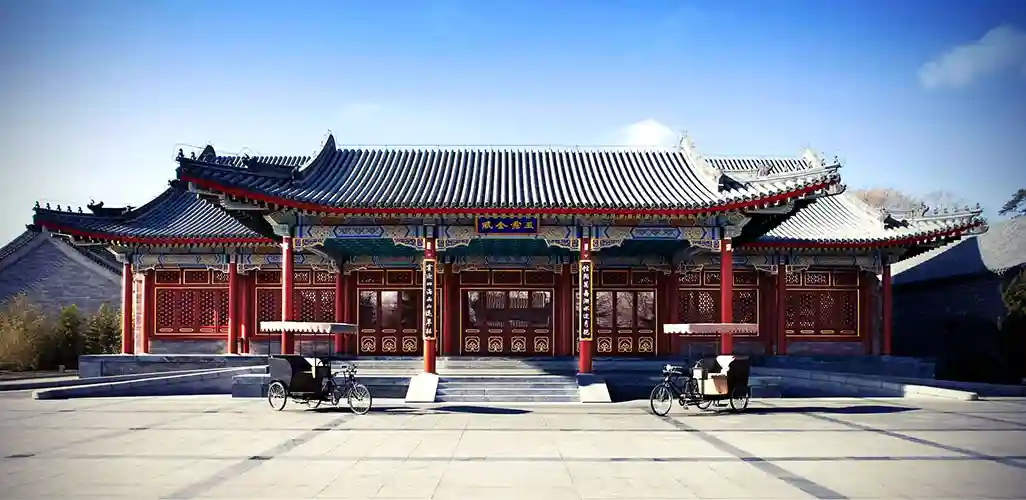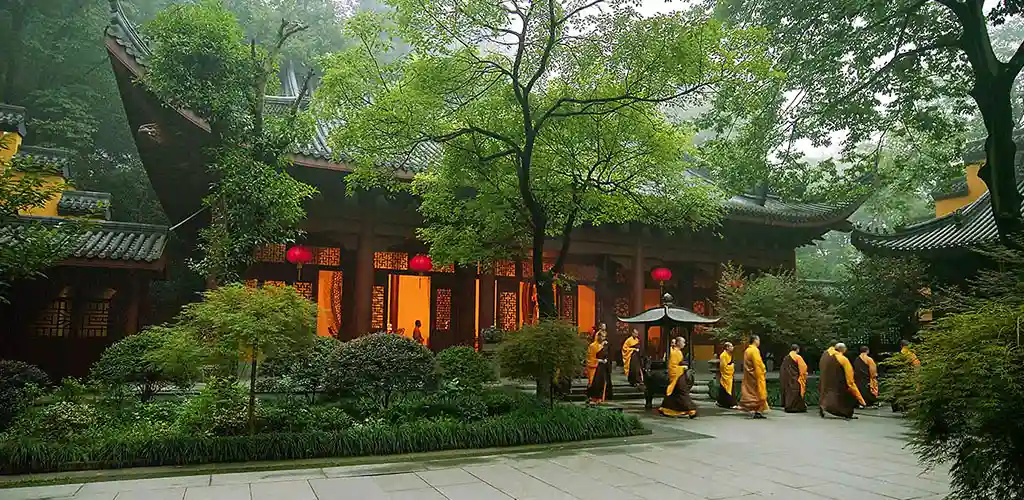CLASSICAL CHINA
Essential and Authentic China
During this private tour explore China's immense cultural treasures including the Great Wall, Forbidden City and Summer Palace in Beijing, Terra Cotta Warriors in Xian, Shanghai's astonishing modernity, and cosmopoliyan Hong Kong. In remote areas, explore ancient villages, the timeless Yangtze, and magnificent landscapes of Guilin. Enjoy a custom curated, meticulously planned and carefully managed journey throughout your travel in China, and our longtime experience provides for insider access and activities few other travelers experience.
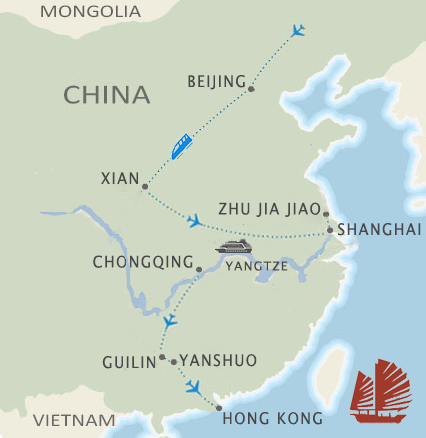
Classic China Highlights
- Iconic Beijing: legendary sites & contemporary architecture.
- Ming dynasty's astonishing terra-cotta warriors in Xi'an
- Zhujiajiao—sublime ancient water town
- Yangzi River gorges and world's largest dam
- Llimestone karst wonderland and terraced rice paddies of Guilin
- Shanghai—China's city of the future
- Historic Hong Kong
- Premier Guides
- Private Touring
- Curated Experiences
Arrive Beijing
Beijing 北京 ("Northern Capital"), China's sprawling capital city of over 22 million people and host of the inspiring 2008 Olympics features an astonishing number of the country's most important ancient historical sites.
After clearing immigration (visa required)* and customs, meet your experienced China guide and after introductions, learn about the capital city as you transfer to Beijing's central Chaoyang District. In afternoon, begin your tour with a perfect introduction to China—The Capital Museum, a seven-story modern architectural gem. The museum features robust high-tech displays covering Chinese traditional and contemporary culture, with collections including ancient pottery, jade, folk, Buddha arts and porcelains, most of which are being showcased for the first time in China. Afterwards, exploring the Olympic Park area, featuring sites from the 2008 games, including the iconic Bird's Nest (National Stadium).
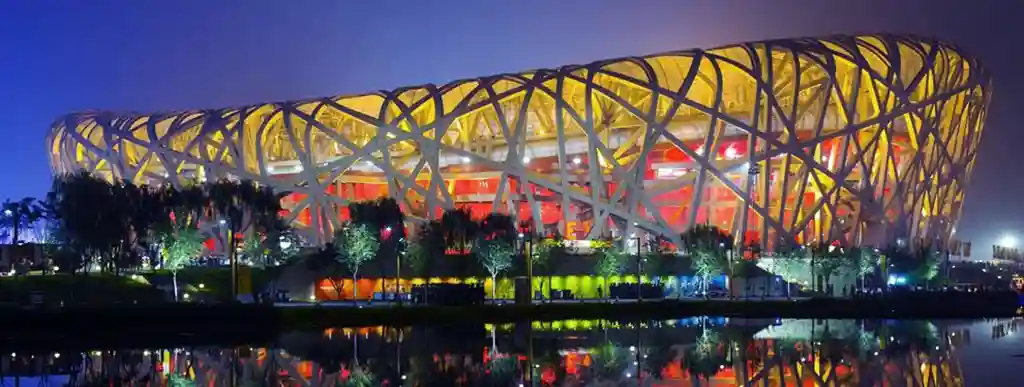
This evening, strolling with guide through Wang Fu Jing's popular pedestrian area, including busy night market, snack street, and taking in the vibrant culinary scene.
*Visa required in advance of arrival (arranged by Indochina Travel)
![]() AMAN AT SUMMER PALACE
AMAN AT SUMMER PALACE
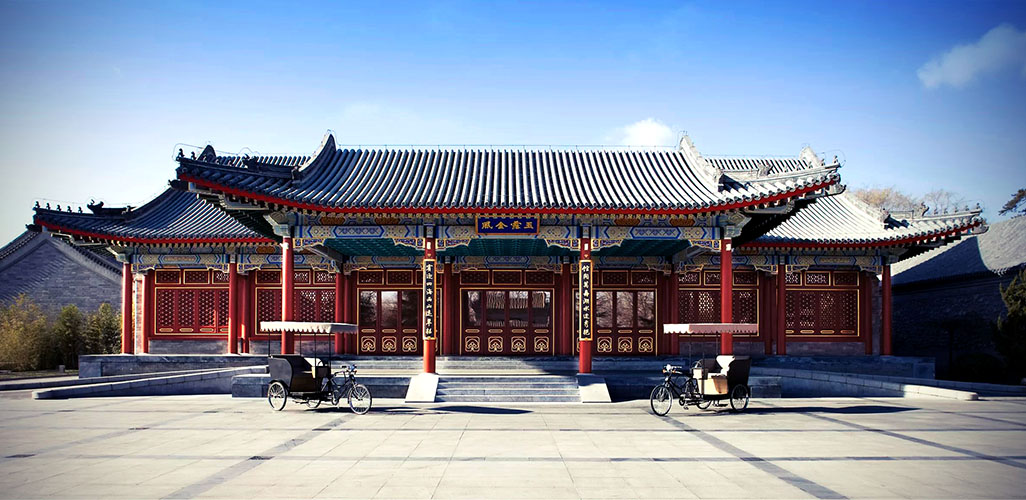
Located behind private gate to the magnificant Summer Palace, Aman's Beijing property offers a tranquil escape from the busy capital after a long day of sightseeing or returning earlier for afternoon tea by the resort's sublime pond. The property was created from a converted collection of original dwellings spread across seven acres and nine courtyards, most of them part of the original 1750 Summer Palace construction by Emperor Qianlong. Guest rooms feature traditional aspects, including sliding latticework doors that unveil majestic wood-beamed ceilings, floors adorned with polished Jin clay tiles, and closets crafted from authentic Chinese wedding chests. The courtyard Chinese Restaurant offers delectable Peking duck accompanied by ancient melodies played on traditional instruments.
Iconic Beijing
Today, exploring the classical highlights of Beijing, visiting the Temple of Heaven 天坛, the jewel of Ming period (1368 – 1644) architecture, where emperors offered prayers for good harvest. The grounds of the sprawling, surrounding park, is an ideal place for people watching and meeting locals who gather for daily their daily socials. You guide will facilitate casual conversations, an elightening exposure to life in the capital city. Nearby and worth a visit is the Hongqiao ("Pearl") Market, Beijing's largest and most popular market for pearl jewelry.
After lunch featuring northern Chinese style cuisine at a local restaurant, visit the world's largest courtyard, Tiananmen Square ("Gate of Heavenly Peace"), a national symbol of China. Tiananmen serves as the entrance to the Imperial City and at its center, the largest Imperial Palace in the world — the Forbidden City a massive complex of nearly a thousand buildings from where succession of 24 emperors of Ming and Qing dynasties ruled for over five centuries. Here, we'll explore some of the collections of the impressive National Palace Museum, with hundreds of thousands of rare artifacts from the Ming and Qing dynasties, including treasured paintings, ceramics, bronzes, and jade pieces.
![]() There is a short hike to the top of adjacent Jingshan (Coal Hill) Park beforehand, behind the Forbidden City, a pleasant park of flowers and trees with panoramic views of the Palace.
There is a short hike to the top of adjacent Jingshan (Coal Hill) Park beforehand, behind the Forbidden City, a pleasant park of flowers and trees with panoramic views of the Palace.
![]() This evening enjoy a dinner at one of the city’s finest and most authentic Peking Duck restaurants.
This evening enjoy a dinner at one of the city’s finest and most authentic Peking Duck restaurants.
![]() The Panjiayuan Antiques Market is called a "once-in-a-lifetime shopping paradise," an open-air market with over 3,000 stalls featuring Chinese arts, crafts, souvenirs and culture icons all in the heart of the city. Stall owners come from twenty-four provinces around China to sell their wares and the range of goods is excellent, but compare and bargain. Panjiayuan Market is largest on weekends but early morning arrival is best to beat traffic. While the best place to pickup crafts and souvenirs, the massive market is worthwhile even for non shoppers for the amazing and interesting variety of goods and people watching.
The Panjiayuan Antiques Market is called a "once-in-a-lifetime shopping paradise," an open-air market with over 3,000 stalls featuring Chinese arts, crafts, souvenirs and culture icons all in the heart of the city. Stall owners come from twenty-four provinces around China to sell their wares and the range of goods is excellent, but compare and bargain. Panjiayuan Market is largest on weekends but early morning arrival is best to beat traffic. While the best place to pickup crafts and souvenirs, the massive market is worthwhile even for non shoppers for the amazing and interesting variety of goods and people watching.
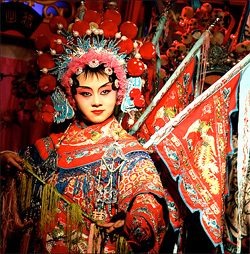 Traditional Beijing opera at the Zhengyici Xilou, last of a handful of theaters that supported Beijing Opera from its beginnings, only occasionally hosts performances and is under constant threat of permanent closure. The scarcity of performances only makes the experience of watching the colorful operas in this intimate, traditionally decorated space all the more precious. Ask us to call and ask about performance schedules and tickets.
Traditional Beijing opera at the Zhengyici Xilou, last of a handful of theaters that supported Beijing Opera from its beginnings, only occasionally hosts performances and is under constant threat of permanent closure. The scarcity of performances only makes the experience of watching the colorful operas in this intimate, traditionally decorated space all the more precious. Ask us to call and ask about performance schedules and tickets.
![]() Yuxiang Renjia 渝乡人家. Featuring Beijing's finest Sichuan including gongbao jiding (diced chicken stir-fried with peanuts and dried peppers).
Yuxiang Renjia 渝乡人家. Featuring Beijing's finest Sichuan including gongbao jiding (diced chicken stir-fried with peanuts and dried peppers).
 Book to pack: On China, by Henry Kissinger
Book to pack: On China, by Henry Kissinger
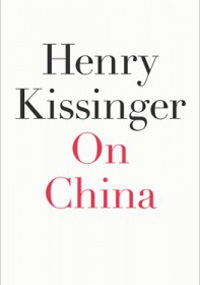
"Drawing on forty years of intimate acquaintance with the country and its leaders, Henry Kissinger reflects on how China’s past relations with the outside world illuminate its twenty-first century trajectory. In this sweeping and insightful history, Henry Kissinger turns for the first time at book length to a country he has known intimately for decades and whose modern relations with the West he helped shape.
On China illuminates the inner workings of Chinese diplomacy during such pivotal events as the initial encounters between China and tight line modern European powers, the formation and breakdown of the Sino-Soviet alliance, the Korean War, and Richard Nixon’s historic trip to Beijing."
The Great Wall
After an early morning departure from Beijing (to avoid its legendary traffic), exploring the best-preserved and most beautiful section of the meandering Great Wall at Mutianyu. Take in the iconic symbol of China by cable car to the top of the Great Wall, taking in the panoramic views and exploring the wall by foot. Incredible as it may seem, the most comprehensive archaeological survey using advanced technologies calculates that the entire Great Wall, with all of its branches, stretches for wider than the continental U.S. at 8,851.8 kilometers (5,500 miles).
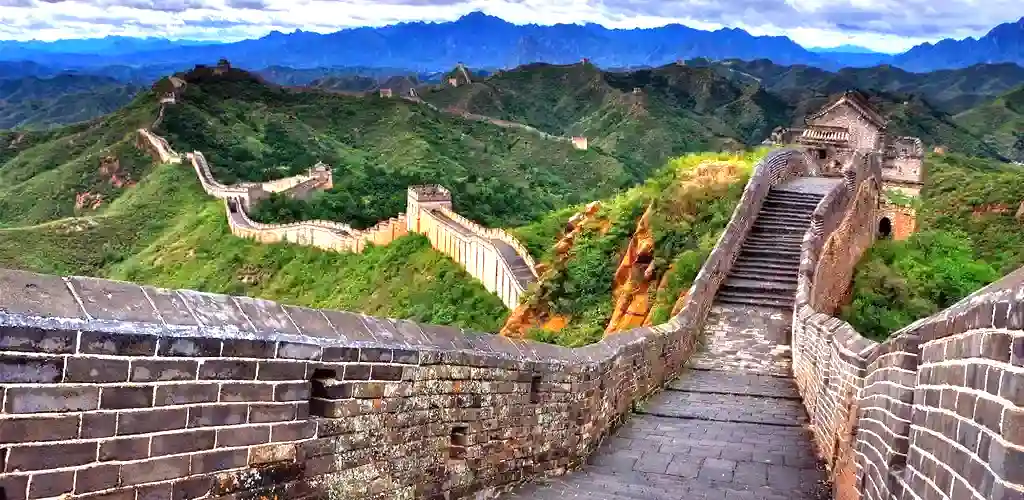
After exploring through the morning, lunching at nearby Xiao Long Pu serving up country style dishes and offering pleasant views of the area. On return to Beijing, stop to visit the Ming Tombs situated in a picturesque region between the Yan Mountains and the Ming Tombs Reservoir. At the tombs, walk the Sacred Way—a half-mile long passageway lined with a series of majestic statues of animals, mythological creatures, military dignitaries and high court officials over which the emperor’s body passed on the way to its final resting place. The Changling Tomb (built in 1409) is located here too, where lies the third Emperor of the Ming Dynasty, Emperor Zhu Di and his Empress Xu. Back in the capital city, we have arranged intimate and authentic custom local experience to tailored your interests, from contemporary artist studios, cooking course, or rickshaw ride through Beijing's ancient alleyways (hutongs), pausing to sip tea with a local family.
Historic Xi'an
After a leisurely morning, transfer by China's newer bullet-train you to Xi'an. This Middle Kingdom city is China's showpiece ancient capital and the city walls are a celebration of both its scale and detail. Wander around them, discovering the turrets and gates where the Great Silk Road originated. Savory dumplings are on the menu later, one of those insatiable treats passed down through the centuries of emperors that ruled from Xi'an. After arrival, enjoying a casual cycling tour of the early-Ming City Walls.
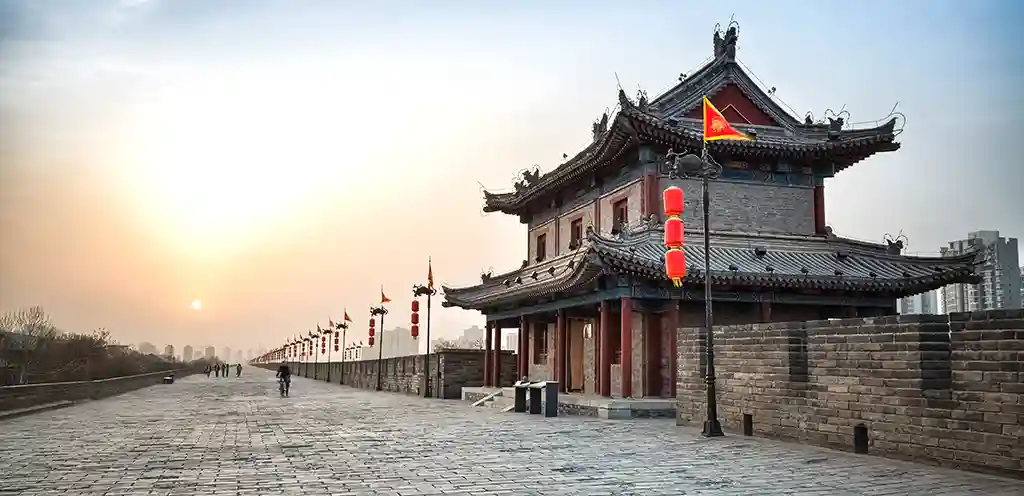
In the afternoon, visiting the old town center's historic monuments to visit, including the Giant Wild Goose Pagoda (A.D. 652) and the Small Wild Goose Pagoda (A.D. 707), both of which were used to store Buddhist monuments brought from India during the Tang Dynasty. Also located here is the Xi'an Museum, housing fine anicent sculptures, ceramics and bronzes.By preference, visit to the Banpo Museum, housing the remains of several Neolithic settlements dating from 5600 - 6700 B.C. or exploring the city's attractions by preference, including the Shaanxi Provincial Museum, Great Mosque, and contemporary sights until late afternoon. After dinner, enjoy a pleasant walk through the shops of the commercial district and the Muslim night market which locals congregate to for the variety of snacks and delicious street food.
![]() SOFITEL LEGEND PEOPLES GRAND HOTEL
SOFITEL LEGEND PEOPLES GRAND HOTEL
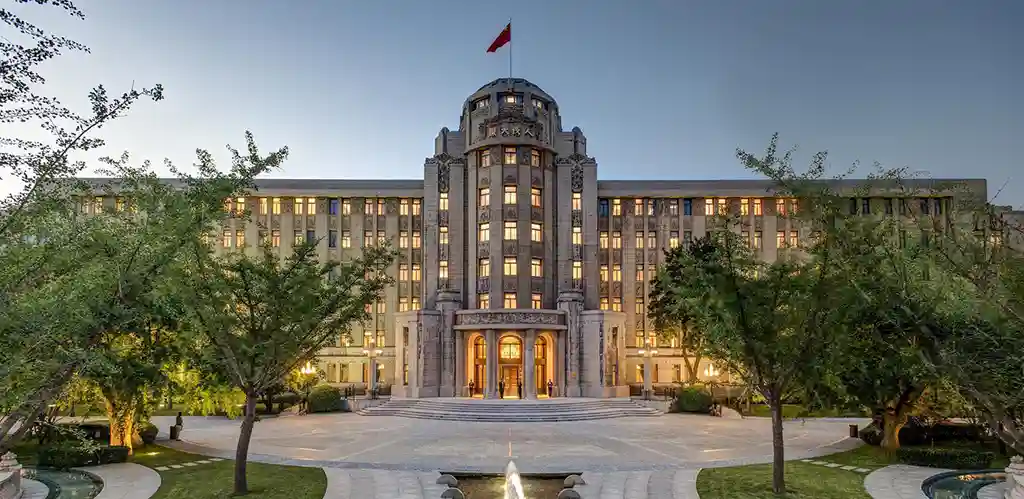
The Grand Dame of Xi'an, featuring an ideal location inside the city walls, within walking distance of historic sights and adjacent to premier shopping and entertainment areas. The legendary hotel was established in 1953 and features a sublime landscaped garden. The Prestige Suite offers sublime views of the garden from large picture windows.
The Terracotta Warriors
The discovery of the Terracotta Army is considered one of the greatest archaeological finds of the 20th century and only the 1922 excavation of the tomb of Tutankhamen was of comparable significance and captured the imagination of the world to a similar degree. Dating from the third century BCE, the thousands of molded soldiers, officers, horses and wagons form a small component of the underground army buried to protect the legendary first Emperor of China during his afterlife. His reign, unifying competing kingdoms, anticipated Xi'an's subsequent rise to global prominence as the capital of a mighty empire in both the Han (206BCE - 220 CE) and Tang (618-907) dynasties.
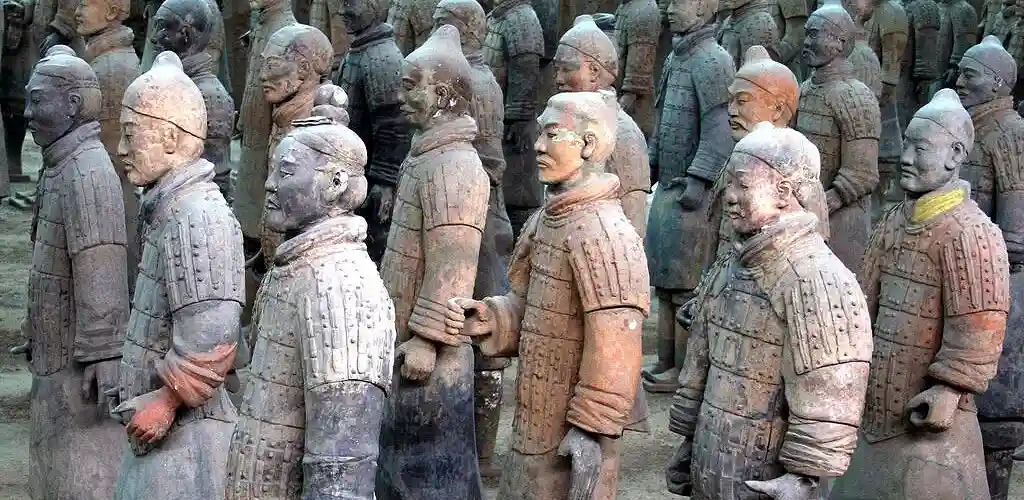
Like the treasure of the boy pharaoh, the terracotta warriors possess a magnetic, almost magical power of attraction. (A dozen complete figures were displayed at the British Museum in 2008. The exhibit lasted for seven months and nearly a million people attended. And even though the museum kept its galleries open until midnight twice a week, visitors still had to be turned away). It was the spring of 1974, and the Cultural Revolution aimed at obliterating China’s extraordinary history had only just ended. Several farmers were digging a well in a nondescript field about an hour’s drive from the ancient city of Xi’an when they unearthed the first fragments of a terracotta figure. Little did they know that beneath their feet were 130 chariots, 670 horses and more than 8,000 soldiers. As well as its epic scale, the Terracotta Army has particular significance because it was buried to accompany the first emperor of China into the afterlife.
During your visit, explorethe three excavation pits with your experienced guide as well as the Bronze Chariot Museum which showcases two bronze chariots, part of the funerary objects buried with the Qinshihuangdi, the first emperor of the Qin dynasty (221 BCE – 210 BCE).
Following lunch near the site, visit the Shaanxi Provincial Museum (closed on Monday). Nicknamed the Uffizi Gallery of China, one of the most stylish and modern museums in China, chock full of exquisite Chinese treasures, including paintings and other artifacts from Tang dynasty tombs in the area. The collection is exceptional–featuring golden bowls and dragons, jade weapons, seals and bracelets, ceramic figures, Tang costumes and personal ornaments. The museum hall displays almost six hundred murals from ancient tombs, featuring various aspects of daily lives of royal families during the Tang Dynasty—several are famous murals known throughout China.
Modern Shanghai
This morning travel by plane to China's modern metropolis, Shanghai, one of the most exciting and dynamic cities in the world. After arrival meet escort for transfer to hotel overlooking the historic Bend. After a first taste of Shanghai cuisine, exploring with your guide by foot along the Bund (外滩 "embankment" — officially known as Zhongshan Road), the symbol of old and new Shanghai on opposite banks, marveling at the various architectural styles lining the Huangpu River beneath the new skyscrapers and around Xīntiāndì, ("New Heaven and Earth") a newer, affluent pedestrian shopping, dining, and entertainment district. During this walk, learn about the area's main role in the history of the city which continues today. This evening, enjoy a dazzling display of spectacular agility when you attend a performance by the Shanghai Acrobatics Troupe, one of the world’s most impressive acrobatics performances.
![]() THE PENINSULA SHANGHAI
THE PENINSULA SHANGHAI
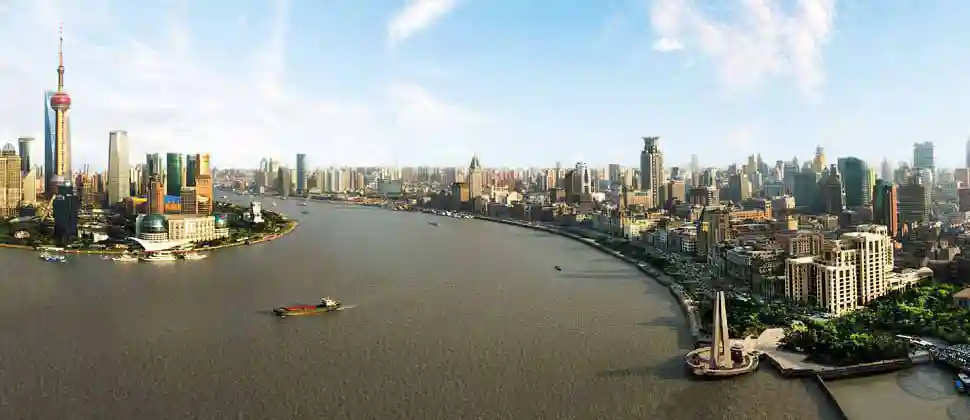
The legendary 1928 elegant Art Deco hotel with top notch service is still a premier property in Shanghai despite dozens of newer properties opening their doors. An ideal location at the end of the Bend with vivid views of Pudong towers across the river which coem alight at night like a giany jukebox. Sir Elly’s Terrace, on the 14th floor, has some of the finest views of any rooftop bar in Shanghai.
Shanghai
Meet your Shanghainese guide for a full-day exploring the city, starting with the historic French concession, also known as "French town," was a special designated foreign area from 1849 to 1946. Here is a glimpse old Shanghai, including pleasant tree-lined streets, ancient alleys, traditional lane houses, art deco villas and apartment blocks, and countless bars, cafés and boutiques—small pockets of the city that have so far managed to escape wide-scale development. The area includes the area of Luwan and Xuhui District, which has always been Shanghai's most charming district. Many of the small back streets still have a very local feel, including Tianzifang, which was originally a typical lane factory area, and has been transformed into arts zone attracting art galleries who have retained the historic architecture and style of old Shanghai.
The Arts and Crafts Research Institute is also located here, a museum in a former French mansion where you can observe artisans engaged in traditional Chinese arts and crafts such as paper cutting, embroidery, and making dough dolls. Here we may spend some time to meet and share experiences with a few younger designers and artists here, with whom younger travelers may share common ground.
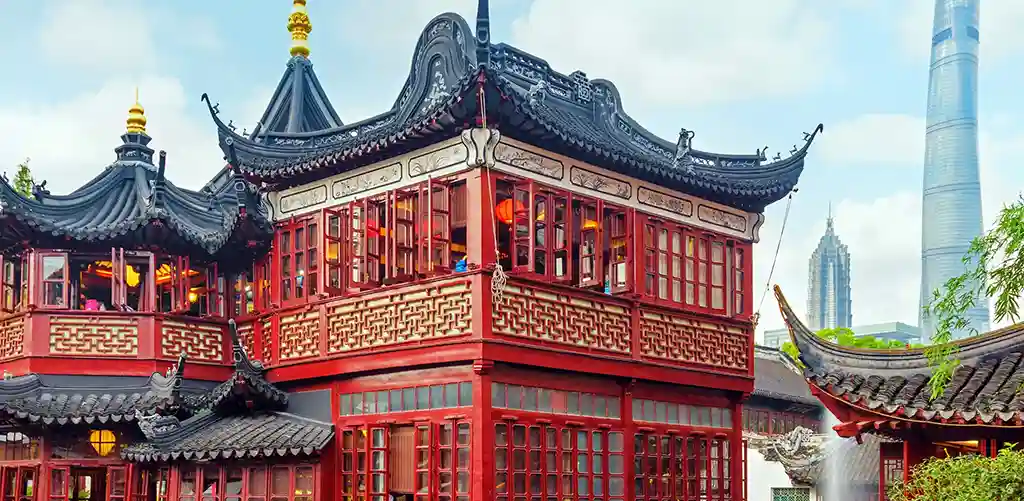
After, continuing through the lanes and alleys of the “Old Town” the historic heart of Chinese Shanghai, where more than 600 years ago was a flourishing area of trade. Shanghai's Old City, for a glimpse of the ancient walled city of Shanghai. During the era of foreign concessions, the old town remained exclusively Chinese, and foreigners seldom ventured there. A highlight located here is the magnificent Yu Garden, an picturesque 16th century scholar’s extensive garden, conceived in 1559 during the Ming Dynasty. During our visit, enjoying a dim sum lunch at the legendary Nan Xiang Xiao Long Bao located within gardens.
Following lunch, visit the world-class Shanghai Museum which catalogs over five thousand years of China's history across eleven sprawling galleries covering most of the major categories of Chinese art, including ancient bronze, ceramics, paintings, calligraphy, sculpture, jade, and coinage. The museum is massive—we suggest focusing only on one or two galleries of interest. The museum also houses an excellent souvenir and gift shop. On the afternoon, explore Nanjing Road, the city's primary shopping corridor.
In the evening, explore the busy Dongchang Road Night Market, the city's most popular.
Ancient Villages
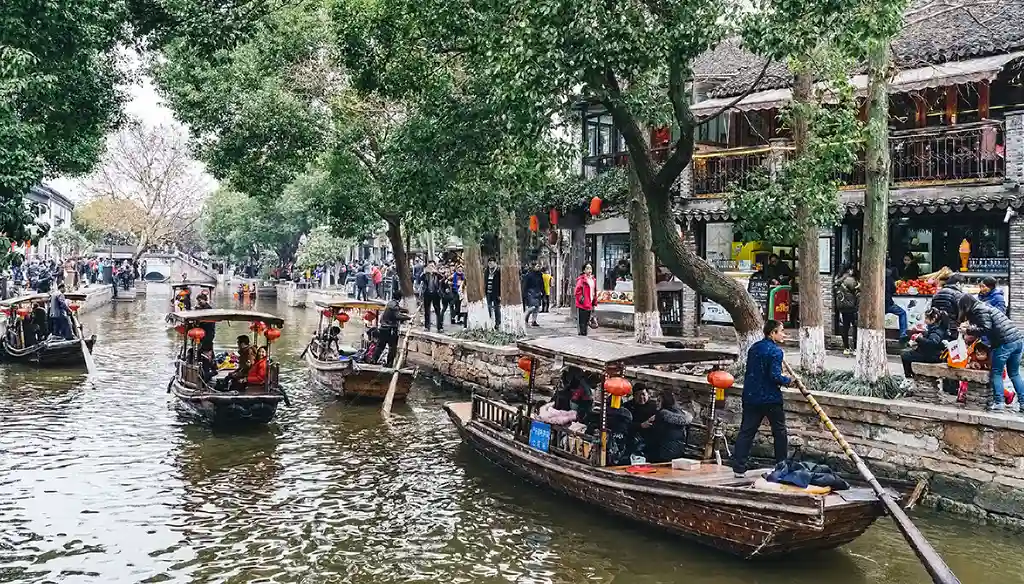
This morning, visit the "Venice of the East" — Zhu Jia Jiao (朱家角 "Zhu Family Settlement"), a water village founded about 1,700 years ago (though archaeological findings dating back over 5,000 years have been found). The village originally prospered through clothing and rice trade and is a classic example of the canal towns that dotted the landscape of the Yangtze River Delta. Dozens of stone bridges and numerous canals line Zhujiajiao, and thousands of ancient buildings still line the riverbanks today. It is the most well preserved in the Shanghai area, many centuries-old stone buildings are home to residents today and old historical buildings such as rice shops, banks, spice stores and even a Qing Dynasty post office. After exploring Zhu Jia Jiao, return to Shanghai for lunch featuring Shanghainese specialties. In the afternoon visit the observation deck of the new Shanghai Tower soaring over two thousand feet above the city streets, the second tallest building on earth. From the observation deck take in the stunning panorama views of Shanghai.
Yangze River Cruise
The quintessential China travel experience is a cruise on Yangtze River (at least during the more pleasant months). As your cruise ship navigates through one of the most spectacular regions of China, marvel up close the magnifocent Three Gorges. During your cruise, take in fascinating shore excursions, inlcuding the Three Gorges Dam, the 816 Underground Project—a Cold War nuclear base and military complex, the White Crane Ridge Underwater Museum, ethnic village of the Tujia people, pagodas, temples, and local markets.
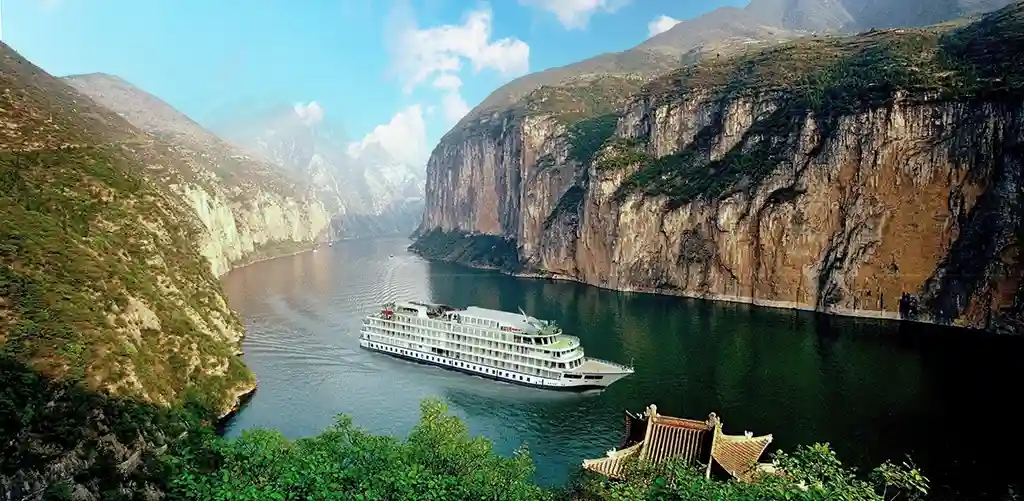
Yangshuo
This morning arrive into Chongqing, disembarking and sightseeing briefly before transfer to Chongqing Airport and boarding flight to Guilin. After arriving in Guilin transfer to Yangshuo resort. Among the Chinese, the area in the southern China province of Guangxi is legendary for its beauty and has served as inspiration for generations of poets and artists. Although there are pleasant parks, a few historic sites, and a night market that are worthwhile to explore, the city of Guilin itself lacks charm (having been heavily bombed during the World War II and rebuilt in the utilitarian style popular in the 1950s). However, it has the immense good fortune of being situated in the middle of some of the world's most beautiful landscapes. This region of limestone karst hills and mountains, rising almost vertically from the earth, has a dreamy, hypnotic quality. Formed over 200 million years ago, when the area was under the sea, the land beneath began to push upward, the sea receded, and the effects of the ensuing erosion over thousands of years produced this sublime scenery. A highlight of a visit to Guilin is a cruise on the Li river, a famous subject of postcard-perfect photographs from travelers who have cruised on the tranquil waterway through the stunning karst geography.
![]() BANYAN TREE YANGSHUO
BANYAN TREE YANGSHUO
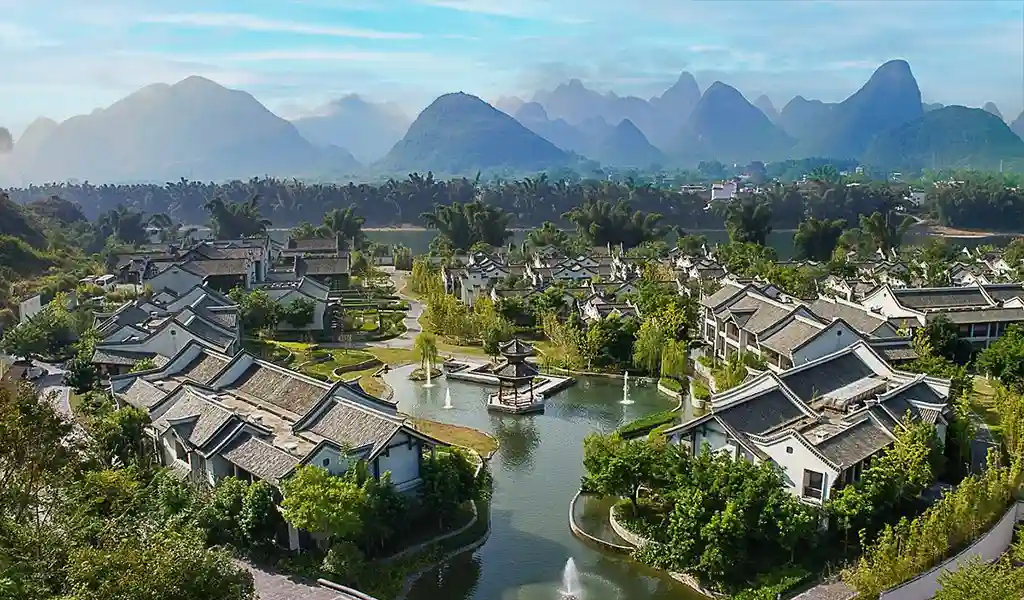
An oasis in Yangshuo, situated in a tranquil and striking setting, remote enough to be quiet, yet not too far from local attractions. Dine on the terrace surrounded by the picturesque mountains, enjoy a swim in the pool nest to the Li River, or walk through the properties lush gardens.
Guilin's Sublime Landscapes
After breakfast, enjoying the quintessential Yangshuo experience—a cruise on Li River (漓江) floating through the sublime karst scenery where the river meanders between Xingping and Yangti, the most beautiful section of the river. The Li River originates in the Mao'er Mountains in Xing'an county and flows about 270 miles through Guilin, Yangshuo and Pingle, down into the Xi Jiang, the western tributary of the Pearl River in Wuzhou.
After cruising past the breathtaking scenery, arrive back in Yangshuo, surrounded by soaring limestone peaks. After docking, visit to the bustling West Street market. Following lunch, explore the ancient village of Fuli, renowned for its traditional handicrafts.
In the evening, a performance of Liusanjie, an hour-long sound-and-light extravaganza set outdoors on the Li River amidst the Karst Mountains. The show features many of the ethnic minorities who live in the surrounding area and the show's director, Zhang Yimou, is also the impresario behind the opening ceremony for the Olympics in Beijing.
Guilin to Hong Kong
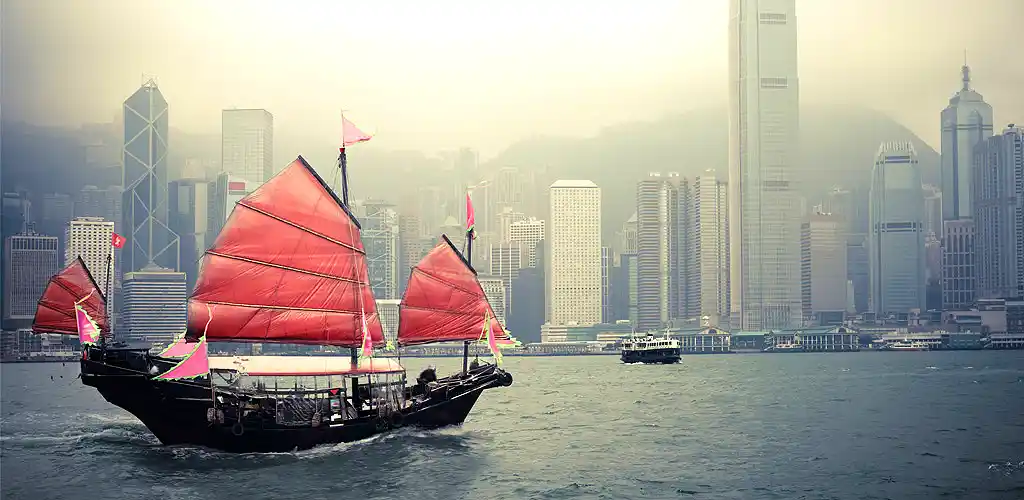
After return to Guilin, enjoy an tour of the city's iconic sights, including the striking forest of stalagmites and stalactites in the Reed Flute Cave and climbing to the top of Fubo Mountain which features sweeping panoramic view of the surrounding countryside. After exploring Guilin, return to airport for flight to Hong Kong. Arrive into Hong Kong 香港, the Pearl of the Orient. Upon exiting terminal, meet escort for private transfer to central Kowloon hotel.
After check-in, we recommend sampling a first taste of Hong Kong's famous dim sum before setting out on your own to explore the busy streets and alleys of Kowloon this evening, browsing the street markets and shops Hong Kong is famous for, with well-stocked shops hawking traditional medicine, jewelry, trendy fashion, and luxury goods of all varieties. Highlights include the bird and flower market and popular Temple Street Night Market.
HIGHLIGHTS
Wong Tai Sin Temple and the Jade Market where in the over 400 stalls, one will understand the deep reverence of the stone for Chinese culture, long associated with long life and good health, making it a prized material for good-luck charms and this is the perfect place to pick up your own specimen.
![]() Winter has the most pleasant months in Hong Kong; dry and not too warm with daytime temps in the 60-70s.
Winter has the most pleasant months in Hong Kong; dry and not too warm with daytime temps in the 60-70s.
![]() Hong Kong has the best Dim Sum in the world. Fook Lam Moon in Wanchai is the city's most exclusive but the Michelin-starred Lei Garden (Central) is less pretentious. For romance of a bygone era, Central's Luk Yu Teahouse retains an Old Hong Kong glamour with its art deco embellishments, retro menu and urban legends. Continental for lunch at Verandah on Repulse Bay. Dinner at Man Wah (roof of the Mandarin Oriental hotel). World-renowned fine Cantonese.
Hong Kong has the best Dim Sum in the world. Fook Lam Moon in Wanchai is the city's most exclusive but the Michelin-starred Lei Garden (Central) is less pretentious. For romance of a bygone era, Central's Luk Yu Teahouse retains an Old Hong Kong glamour with its art deco embellishments, retro menu and urban legends. Continental for lunch at Verandah on Repulse Bay. Dinner at Man Wah (roof of the Mandarin Oriental hotel). World-renowned fine Cantonese.
Retro-chic China Club remains Hong Kong's most exclusive table (advanced reservations required). No visit to Hong Kong is complete with admiring the jaw-dropping views at sunset from many of the high-tower lounges or restaurants, such as Felix (Peninsula Kowloon). Other top dining choices are Caprice at the Four Seasons (with its three Michelin stars), Amber for fusion at the Mandarin Oriental, uber trendy Italian "8 ½" (also earner of three Michelin stars), also for fine dinging consider the Mandarin Grill also in the Mandarin Oriental for "molecular" dishes. Man Wah (roof of the Mandarin Oriental hotel). World-renowned fine Cantonese.
For local flavor, "the world's cheapest Michelin-starred restaurant" —Tim Ho Wan— is located firmly in the backstreets of Mong Kok, serving up dim sum and other Chinese favorites. Other more casual choices include, Lung King Heen serves three-star Michelin Cantonese with sweeping views of the harbor from the Four Seasons. T'ang Court at the Langham is well regarded for its Chinese cuisine and Nanhai No. 1 features seafood with magnificent views of the skyline from Nathan Road. An informal favorite in central is The Chairman featuring steamed crab and spare ribs.
Private kitchens are a recent trend, intimate dinging in local homes of chefs. Contact us for top choices.
![]() Feeling a bit crowded? Hong Kong is the most densely populated city in the world and within the city, the area most squeezed is the Mongkok district in Kowloon (over 130,000 people per square kilometer). Hong Kong also boasts the most skyscrapers in the world (about 8,000, double that of 2nd place Manhattan), and Rolls Royces per capita.
Feeling a bit crowded? Hong Kong is the most densely populated city in the world and within the city, the area most squeezed is the Mongkok district in Kowloon (over 130,000 people per square kilometer). Hong Kong also boasts the most skyscrapers in the world (about 8,000, double that of 2nd place Manhattan), and Rolls Royces per capita.
![]() Jewelry shops in Hong Kong include Youmna, owned by a U.S.-trained French-Lebanese Youmna, whose malte and white gold body pieces are as stylish, and versatile as she is. Central, by appointment only. Tayma Fine Jewelery, Prince's bldg, 10 Charter Road Central, Tel: 2525 5280, closed Sunday (taymajewellery.com). Kim Lai features Sleek, minimalist and refined, for guys and gals,49-51 Gough St., Central, Tel: 2545 6388 (kimlai.net). Candice Luk. Whimsical feminine, vintage-inspired pieces. By appt only. (candiceluk.com). Sandy Chung. Hordes of high quality pearls, girls, made into lariats earrings and more, ready to go or custom. Stall No. 413-414, Jade market, Kansu St., Kowloon , Tel: 2771 0901 or 9831 4963, 12-5pm daily, call ahead. David Kingsboro. Brides-to-be come for the unbeatable diamonds, hubbies-to-be for the unbeatable prices. 2f Entertainment Bldg, 30 Queen's Rd., Central, Tel: 2522 0203.
Jewelry shops in Hong Kong include Youmna, owned by a U.S.-trained French-Lebanese Youmna, whose malte and white gold body pieces are as stylish, and versatile as she is. Central, by appointment only. Tayma Fine Jewelery, Prince's bldg, 10 Charter Road Central, Tel: 2525 5280, closed Sunday (taymajewellery.com). Kim Lai features Sleek, minimalist and refined, for guys and gals,49-51 Gough St., Central, Tel: 2545 6388 (kimlai.net). Candice Luk. Whimsical feminine, vintage-inspired pieces. By appt only. (candiceluk.com). Sandy Chung. Hordes of high quality pearls, girls, made into lariats earrings and more, ready to go or custom. Stall No. 413-414, Jade market, Kansu St., Kowloon , Tel: 2771 0901 or 9831 4963, 12-5pm daily, call ahead. David Kingsboro. Brides-to-be come for the unbeatable diamonds, hubbies-to-be for the unbeatable prices. 2f Entertainment Bldg, 30 Queen's Rd., Central, Tel: 2522 0203.
![]() Central, the city's business district, is flush with a collection of designer boutiques located in a series of buildings including the Alexandra House, Charter House, Prince’s Building and The Landmark. High-end department stores include Prada and specialized shops like Paule Ka for high-end French fashion, Ascot Chang for hand-tailored Italian suits, and Baccarat for luxurious crystal and jewelry.
Central, the city's business district, is flush with a collection of designer boutiques located in a series of buildings including the Alexandra House, Charter House, Prince’s Building and The Landmark. High-end department stores include Prada and specialized shops like Paule Ka for high-end French fashion, Ascot Chang for hand-tailored Italian suits, and Baccarat for luxurious crystal and jewelry.
For a more colorful, local shopping experience, head over to Causeway Bay (East of the Central and Wan Chai districts). Yee Woo street is the area’s main thoroughfare and splits the shopping district in two, with a forest of neon signs and abundance of local and international stores packed with shoppers. SOGO is the biggest and the most popular department store in Hong Kong with 12 stories hawking everything from high fashion to cosmetics to electronics to toys for kids. Times Square (on Russel Street) holds over 230 shops and has some delicious eateries on its upper floors. Fashion Walk is a street of hip shops and boutiques showcasing local fashion designers and trends (Kingston Street). A younger, fashion-seeking crowd, although there are shops there to suit all tastes and age. The Island Beverley Centeron George Street also holds hundreds of independent retailers.
![]() THE PENINSULA HONG KONG
THE PENINSULA HONG KONG
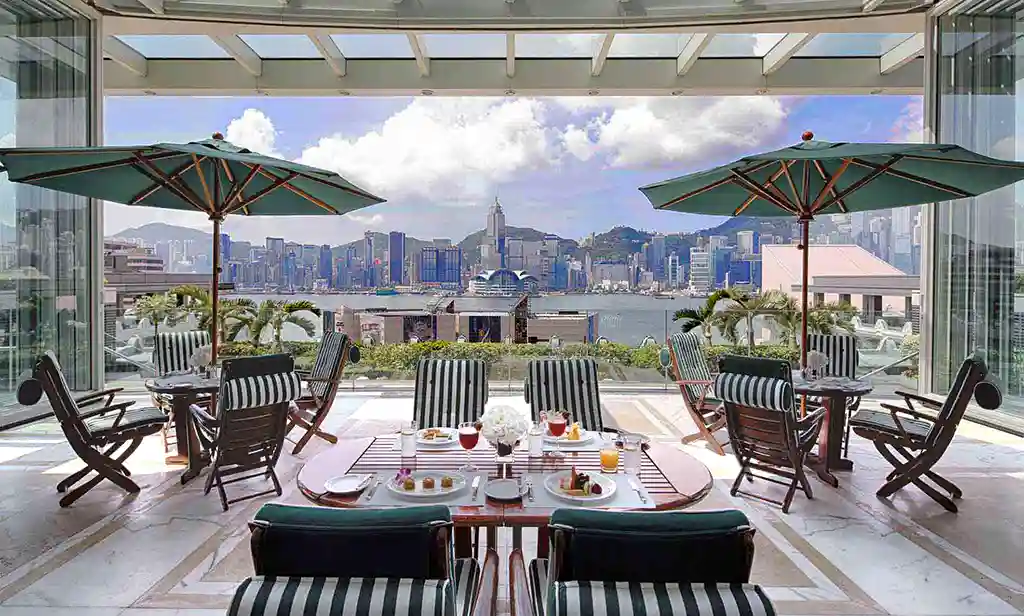
Another gem from the Peninsula. Though most luxury hotels are on Hong Kong Island proper, we recommend being closer to the action in Kowloon (with fine views of the island, above).
A Day in Hong Kong
This morning, begin exploration of Hong Kong with a guided walk in the historic Sheung Wan District, famed for its dried foods and herbal medicine shops, pharmacies and markets. Then continue on to the Man Mo Temple, the oldest Daoist temple in Hong Kong and a rich reminder of the philosophical traditions of Hong Kong. After, crossing over the Central, then boarding the funicular up to Victoria Peak to enjoy breathtaking panoramic views of city followed by an optional stroll around the summit.
Afterwards, enjoy a cruise in a traditional sampan through the waters of Aberdeen home to the Tanka Fishing people, a reclusive group of fisherman who once numbered more than 500,000 but today are a quickly vanishing way of life. After a traditional Dim sum lunch return to hotel for afternoon to relax or explore and shopping at your leisure.
![]() Jewelry shops in Hong Kong
Jewelry shops in Hong Kong
Youmna: U.S.-trained French-Lebanese Youmna's malte and white gold body pieces are as stylish, intland versatile as she is. Central, by appointment only. Tayma Fine Jewellery, Prince's bldg, 10 Charter Road Central, Tel: 2525 5280, closed Sunday). Kim Lai features Sleek, minimalist and refined, for guys and gals,49-51 Gough St., Central, Tel: 2545 6388 (kimlai.net). Candice Luk. Whimsical feminine, vintage-inspired pieces. By appt only. Sandy Chung. Hordes of high quality pearls, girls, made into lariats earrings and more, ready to go or custom. Stall No. 413-414, Jade market, Kansu St., Kowloon , Tel: 2771 0901 or 9831 4963, 12-5pm daily, call ahead. David Kingsboro. Brides-to-be come for the unbeatable diamonds, hubbies-to-be for the unbeatable prices. 2f Entertainment Bldg, 30 Queen's Rd., Central, Tel: 2522 0203.
![]() Central, the city's business district, is flush with a collection of designer boutiques located in a series of buildings including the Alexandra House, Chater House, Prince’s Building and The Landmark. High-end department stores include Prada and specialized shops like Paule Ka for high-end French fashion, Ascot Chang for hand-tailored Italian suits, and Baccarat for luxurious crystal and jewelry.
Central, the city's business district, is flush with a collection of designer boutiques located in a series of buildings including the Alexandra House, Chater House, Prince’s Building and The Landmark. High-end department stores include Prada and specialized shops like Paule Ka for high-end French fashion, Ascot Chang for hand-tailored Italian suits, and Baccarat for luxurious crystal and jewelry.
For a more colorful, local shopping experience, head over to Causeway Bay (East of the Central and Wan Chai districts). Yee Woo street is the area’s main thoroughfare and splits the shopping district in two, with a forest of neon signs and abundance of local and international stores packed with shoppers. SOGO is the biggest and the most popular department store in Hong Kong with 12 stories hawking everything from high fashion to cosmetics to electronics to toys for kids. Times Square (on Russel Street) holds over 230 shops and has some delicious eateries on its upper floors. Fashion Walk is a street of hip shops and boutiques showcasing local fashion designers and trends (Kingston Street). A younger, fashion-seeking crowd, although there are shops there to suit all tastes and age. The Island Beverley Centeron George Street also holds hundreds of independent retailers.
Departure from Hong Kong
Return to Hong Kong International by private car, and after farewells with your guide, enter terminal for international flight. (B)

